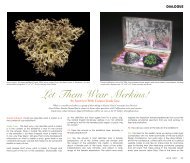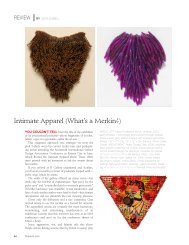Creative Flow: Three Activist Artists - Linda Gass
Creative Flow: Three Activist Artists - Linda Gass
Creative Flow: Three Activist Artists - Linda Gass
Create successful ePaper yourself
Turn your PDF publications into a flip-book with our unique Google optimized e-Paper software.
<strong>Creative</strong> <strong>Flow</strong><br />
<strong>Three</strong> <strong>Activist</strong> <strong>Artists</strong><br />
52 fiberarts.com<br />
by Sally Hansell<br />
Using marine debris, painted silk,<br />
and paper, artist Pam Longobardi,<br />
<strong>Linda</strong> <strong>Gass</strong>, and Lauren Rosenthal<br />
advocate for greater consciousness<br />
of our fragile water systems.<br />
Powerful new work by three activist artists addresses<br />
one of the nation’s most critical issues—the steady<br />
degradation of our precious water supply. Pam Longobardi<br />
uses plastic trash collected on beaches to<br />
make provocative art that points to the devastating dangers of<br />
plastic in our environment. <strong>Linda</strong> <strong>Gass</strong> creates vibrant painted-silk<br />
quilt works depicting specific ecological hazards in San<br />
Francisco Bay. Lauren Rosenthal turns watershed data into cutpaper<br />
sculptures to demonstrate the interconnectedness of rivers<br />
and earthly organisms. Through their chosen media, these<br />
diverse artists advocate for a heightened global ecological consciousness.<br />
In 2006, Pam Longobardi launched an ongoing project<br />
called Drifters after encountering mounds of consumer waste<br />
on the beach at South Point, the southernmost tip of the<br />
Hawaiian Islands. The project includes photography, sculpture,<br />
public art, and installations made from the debris that<br />
washes up on shores around the world.<br />
The Atlanta artist creates “driftwebs” from abandoned drift<br />
nets, the miles-long fishing nets that wreak havoc on sea life,<br />
killing fish, mammals, turtles, and birds. She cuts and ties<br />
pieces of the nets to make installations resembling spider<br />
webs. Her intent is not only to draw attention to the dangerous<br />
plastic nets, but more importantly, to use their woven<br />
colorful forms as a dual metaphor for the predatory, destructive<br />
behavior of humankind and the interconnectedness of<br />
the web of life.<br />
During the 2009 Venice Biennale, various Drifters works<br />
were on view in a solo exhibition at ARTLIFEfortheworld Gallery<br />
in Venice. In Canal Driftweb (2009), Longobardi draped<br />
a multicolor web across the gallery’s crumbling brick exterior.<br />
Rope-like netting, radiating from a central point, was tied to<br />
grated windows, a bridge, and other architectural elements before<br />
spilling into a boat moored to a nearby dock. The theme of<br />
interconnectedness was reinforced by the title of the exhibition,<br />
Pathalassa, a reference to the hypothetical single ocean that<br />
surrounded the prehistoric supercontinent Pangaea on earth.<br />
Inside the gallery, a sculpture called Shipwreck (Unintended<br />
LEFT: Pam Longobardi collecting drift net on the Big Island, Hawaii,<br />
2008. Photo: David Rothstein
Consequences) (2009) depicted half a splintered boat constructed<br />
of black plastic tubes from Japanese oyster aquaculture<br />
pens. Behind the vessel, a skein of tangled nets, rope, and<br />
plastic objects floated across the floor like the entrails of a harvested<br />
whale. Longobardi had found the tubes and some of the<br />
nets at South Point, while the other marine debris was gathered<br />
from Italian beaches.<br />
Through the repurposing of refuse into<br />
vibrant supersized webs and sculptural forms,<br />
Longobardi wants to project “a picture of<br />
ourselves so that we may see ourselves more<br />
clearly.” In addition to making three-dimensional<br />
art, she takes photographic “portraits”<br />
of individual objects, which are often highly<br />
personal things such as combs and toothbrushes,<br />
toys, and shoe soles found on beaches.<br />
As the Georgia State University, Atlanta, art<br />
professor explains in her new book, Drifters:<br />
Plastics, Pollution, and Personhood (Milan: Charta,<br />
2009. Reviewed in our Catalogs section on<br />
page 60),”These works pose a mirror in front<br />
of the viewer in that one can recognize the self<br />
and one’s own participation in the creation of<br />
this materiality.”<br />
ABOVE: Pam Longobardi, Shipwreck (Unintended Consequences)<br />
(with detail), 2009; found marine debris: drift net, toy-truck wheels,<br />
oyster aquaculture spacer bars, flyswatter, air-freshener mount, shoe<br />
sole, umbrella handle, fishing-net float, sumi-ink bottle, wire, wire<br />
mesh; dimensions variable. Installation for Panthalassa exhibition,<br />
ARTLIFEfortheworld Gallery, Venice, Italy. BELOW: Pam Longobardi,<br />
Driftweb II, 2009; found ropes, nets, marine debris. Installation for<br />
Panthalassa exhibition, ARTLIFEfortheworld Gallery, Venice, Italy.<br />
Photos by the artist.<br />
Fiberarts2010SUMMER<br />
53
54 fiberarts.com<br />
Artist <strong>Linda</strong> <strong>Gass</strong> gets “local, personal and dirty” in her<br />
new trio of painted quilted works. Her small-scale silk wall hang-<br />
ings depict with specificity where her sewage goes, where her<br />
garbage goes, and where her gasoline gets refined. Providing<br />
aerial views of a water treatment plant, a landfill and an oil<br />
refinery, all on the shore of the San Francisco Bay, the beguiling<br />
works lure the viewer in close with rich hues, intimate forms,<br />
and exquisite craftsmanship, leading to engagement with the<br />
political subtext.<br />
The seed for the quilts came from hearing a talk by environmental<br />
writer Gary Snyder ten years ago. <strong>Gass</strong> recalls Snyder<br />
quizzed the audience with questions like, “How local are you?<br />
Do you know where your water comes from and where it goes?”,<br />
She found the answers after joining a local Green Ribbons Citi-<br />
zens’ Committee, a grassroots environmental policy group that<br />
took informative trips to landfills, recycling centers, and sewage<br />
treatment plants near her Los Altos, California, home.<br />
In art that fuses painting and stitching, <strong>Gass</strong> applies Rem-<br />
azol fiber-reactive dyes and water-soluble resist to silk crepe<br />
de chine. She uses machine stitching to outline her pictorial<br />
images and create details such as eddies and cracked earth.<br />
The modest-sized works have a pronounced sculptural quali-<br />
ty achieved through stitching, thick batting and gradations of<br />
color. Questioning titles—Treatment?, Sanitary? and Refined?<br />
(all 2009)—create a tension between the formal beauty of the<br />
works and their political content. While the titles engage the<br />
viewer, the dialogue is carried further by accompanying text<br />
statements by the artist that identify the depicted facilities, cite<br />
their noxious impact, and conclude with a call for greater pro-<br />
tection of our globe.<br />
Lauren Rosenthal’s inventive sculptures of watersheds<br />
evolved out of nomadic camping trips on the banks of the Haw<br />
River in north central North Carolina, where after college she<br />
helped run an environmental educational program for children.<br />
As an MFA student at the University of North Carolina at Cha-<br />
pel Hill, she began making river maps, adopting cartography<br />
as her visual language. Since 2008, she has used hydrological<br />
and topographical data to create a series of paper sculptures of<br />
specific river basins on the East Coast. Like <strong>Gass</strong> and Longo-<br />
bardi, Rosenthal considers herself an activist, but her art takes<br />
a more subtle approach. Her all-white paper carvings have an<br />
austere, meditative beauty that evokes the fragility and ideal<br />
purity of watersheds. “The white is a negation of our own real<br />
experience of landscape,” the New Jersey resident says.<br />
When discussing her work, Rosenthal emphasizes the of-<br />
ten unquestioned authority of maps in manipulating our ideas.<br />
LEFT: Treatment? (TOP); Sanitary? (MIDDLE); Refined? (BOTTOM).<br />
All by <strong>Linda</strong> <strong>Gass</strong>, 2009; silk crepe de chine, silk broadcloth backing<br />
and polyester batting, rayon and polyester embroidery thread;<br />
handpainted using Remezol dyes and water-soluble resist,<br />
machine-quilted; 30” x 30”. Photos: Don Tuttle.
“My work employs the power of maps. By emphasizing some<br />
information—river data—and eliminating other information—roads<br />
and labels, I propose a particular ecocentric view of the<br />
world we inhabit with the hope that we might think differently<br />
about ourselves as subjects within it,” she explains.<br />
To make her intricate relief sculptures, she uses data obtained<br />
from geographic information systems (GIS). Using an<br />
X-acto knife, she cuts the shape of each elevation layer on individual<br />
sheets of 300-pound watercolor paper, detailing even<br />
the tiniest streams. The multilevel works include up to seventeen<br />
layers of paper glued together.<br />
Imagining a world in which water is the defining element<br />
for the sociopolitical structure, in 2006 Rosenthal created her<br />
own atlas of the contiguous United States. Watershed divides<br />
serve as territorial boundaries instead of the current state borders,<br />
allowing citizens to locate themselves within the river<br />
district on which they depend. Titled Political/Hydrological: A<br />
Watershed Remapping of the Contiguous United States, the work<br />
features forty-eight maps and an introduction compiled into a<br />
limited edition artist’s book.<br />
Each of these three artists uses a different language for addressing<br />
the plight of our planet—the universally grasped lingo<br />
ABOVE: Lauren Rosenthal, Delaware River Anatomy (with detail),<br />
2008; watercolor paper, wood, paint, hand-cut, painted; 60” x 36” x<br />
18”. Photos by the artist.<br />
of plastic, the poetry of color and thread, and the data of cartography.<br />
Through engaging our imaginations, these profound<br />
works remind us that the dialogue between humans and our earth<br />
FA<br />
must deepen and change.<br />
Pam Longobardi’s website is www.pamlongobardi.com. Longobardi<br />
will have two solo shows on view this summer: Material Drift at San-<br />
dler Hudson Gallery, Atlanta, May 21–July 3, www.sandlerhudson<br />
.com, and Selections at Tinney Contemporary, Nashville, Tennessee,<br />
June 19–July 31, www.tinneycontemporary.com. To read a review of<br />
her new book Drifters: Plastics, Pollution and Personhood, turn to<br />
page 60. <strong>Linda</strong> <strong>Gass</strong>’s website is www.lindagass.com. <strong>Gass</strong>’s work<br />
is included in the Women Environmental <strong>Artists</strong> Directory (WEAD)<br />
Exhibit 2010 at Art & Consciousness Gallery, John F. Kennedy Uni-<br />
versity, Berkeley, California, through June 12, www.jfku.edu/gallery;<br />
and the Arts Council Silicon Valley Artist Fellowship Awards Exhibition,<br />
Triton Museum, Santa Clara, California, May 15–June 20, www<br />
.tritonmuseum.org. Lauren Rosenthal’s website is www.laurenrosen<br />
thalstudio.com. Rosenthal’s work is included in Emerging Patterns,<br />
through August 31, at the Arts Council of the Morris Area, Morris-<br />
town, New Jersey, www.morrisarts.org.<br />
Fiberarts2010SUMMER<br />
55




